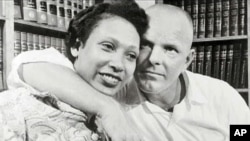When President Barack Obama’s Kenyan father and American mother married in 1961, interracial marriage was still illegal in 22 states, nearly half the country. It wasn’t until the Supreme Court struck down anti-miscegenation laws in 1967 that mixed-race marriage became legal throughout the United States. The case that led to that historic decision was filed by an interracial married couple, Richard and Mildred Loving. Their story is the subject of a new documentary called The Loving Story that screened recently at the Tribeca Film Festival in New York and will debut on HBO in February 2012.
It’s a little-known story compared to other historic civil rights cases, says director Nancy Buirski, a North Carolina filmmaker. She says she was surprised to find that no documentaries had been made about the Lovings. When she came upon footage of the couple shot in the sixties by filmmaker Hope Ryden, she knew she could tell their story from their point of view, as they lived it.
Richard Loving and Mildred Jeter met in 1951 when Mildred was 11 and Richard 17. He was white; she was of African and Native American ancestry. They grew up in the same Virginia town of Center Point where blacks and whites had long mixed informally, despite segregation. Mildred later recalled what it was like.
"The whites and colored went to school differently," Mildred Jeter said. "Things like that, you know. You couldn’t go in the same restaurants. I knew that. But I didn't realize how bad it was until we got married."
In 1958, when Mildred was 18, she became pregnant. Because Virginia law prohibited interracial marriage, she and Richard wed in nearby Washington, D.C. Six weeks later, police broke down the door of their small house in Center Point and arrested them.
"I guess it was about 2 a.m.," Mildred recalled. She describes that night in the documentary: "And I saw this light, and I woke up, and it was the police standing beside the bed, and he told us to get up, that we were under arrest."
The Lovings were jailed and charged with violating Virginia’s anti-miscegenation laws. Their sentence was banishment, for 25 years, from the state. They moved to Washington, D.C. and had three children. But Mildred was so unhappy that, in 1963, she wrote then-attorney general Robert F. Kennedy, asking if new civil rights laws would help. He told her to contact the American Civil Liberties Union. Two young lawyers, Bernard S. Cohen and Philip J. Hirschkop, took the case.
In The Loving Story, Cohen explains what they faced. "Challenging the anti-miscegenation laws was the most serious threat to the white racists, and even those whites who were not racist, but were very pro-establishment," he said. "I looked at it as an unbelievable challenge for a lawyer, one or two years out of law school, to be getting involved in what was sure to be a major civil rights case."
Robin Lenhardt, a professor at Fordham Law School in New York, says other race separation laws were rooted in fear of blacks and whites becoming intimate. For example, she says, "laws prohibiting black and white students from going to school together were ultimately very much about fears of interracial marriage, about what some of the people interviewed in the film might call the ‘mongrelization’ of the white race. There was concern about preserving its purity, which is troubling on lots of levels, and comical, also, because so many of the people who professed to be white were mixed-race themselves."
As Nancy Buirski notes, the Lovings were quiet, working class people uncomfortable in the spotlight. When the case reached the Supreme Court, they didn't even attend the arguments. "And that wasn’t surprising, given how reticent they were about publicity in general," Buirski says. "They were a very modest, humble couple. They really weren’t doing this to change history. They never saw themselves as heroes."
Yet Buirski says they did become heroes through their sheer desire to remain married and raise their children in the place they loved. "Apparently they never disagreed about any of it, they were very much in love, and as far as I am concerned, they in some ways upend stereotypes, because they weren’t activists, they just wanted to go home and live in Virginia, with their families."
On June 12, 1967, the U.S. Supreme Court upheld the Lovings and struck down the anti-miscegenation laws in the 16 US states that still had them. The couple returned to their Virginia town. Richard built them a home where they lived the rest of their lives. He died in 1975 when a drunk driver hit his car. Mildred died in 2008.
Since the Loving decision, rates of interracial marriage have climbed steadily each year. Today, about eight percent of all marriages and nearly 15 percent of new marriages in the United States are racially mixed. The anniversary of the decision, June 12, is now celebrated unofficially as "Loving Day" by some interracial couples and, increasingly, gays and lesbians seeking the right to marry throughout the United States, a cause Mildred Loving also supported in her later years.








